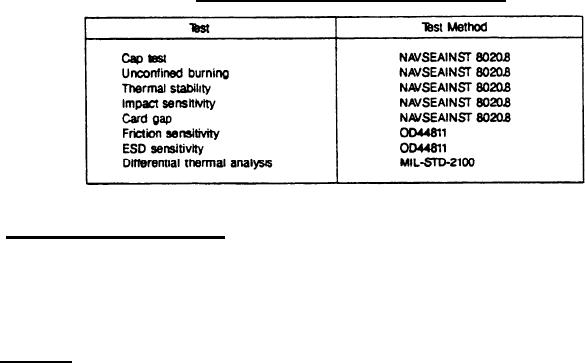 |
|||
|
Page Title:
Table VI. Energetic material hazard characteristic tests. |
|
||
| ||||||||||
|
|  MIL-I-85889(AS)
TABLE VI. Energetic material hazard characteristic tests.
4.2.13 Cornponent compatibility tests. The contractor shall conduct compatibility tests to determine the effects
of interaction among energetic materials, adhesives, lubricants, metallic and non-metallic materials Tests may include
differential thermal analysis, accelerated aging studies, and other means to project the effects of time- The test
results shall demonstrate that the igniter's service life is not compromised because of material incompatibilities
inherent in the design. Results of compatibility testing shall be documented in the Design Development Report
(see 4.235).
4.2.2 Analyses.
4.2.2.1 Life cycle environmental analysis. When specified in the contractor order, the contractor shall conduct
a life cycle environmental analysis to determine the expected environments for the igniter. Typically, the life cycle
consists of the following sequence:
Manufacture
a
.
Packaged into shipping container for Type II or loaded into rocket motor for Type I and then packaged
b
.
Transported to depot
c
.
Stored at depot
d
.
Transported to user
e
.
Unpackaged from shipping container
f
.
g
.
Built-up into operational configuration
h
.
Transported to lauynch site
i
.
Attached to platform
j
.
Platform launch
k
.
Expended remains scrapped
However, any given igniter may have a significantly different life cycle Using the guidelines of MIL-STD-810 and
MIL-D-1670, the contractor shall consider the potential environment in terms of stimuli, such as temperature,
pressure, shock, vibration, rain, humidity, salt spray, and dust. The following factors should also be taken into account
for the possible environments to which material will be exposed:
a.
Configuration of hardware
b.
Environment that is encountered (climate of)
c.
Platform with which the hardware interfaces
d.
Interfaces with other equipment
e.
Absolute and relative duration of exposure phase
11
|
|
Privacy Statement - Press Release - Copyright Information. - Contact Us |